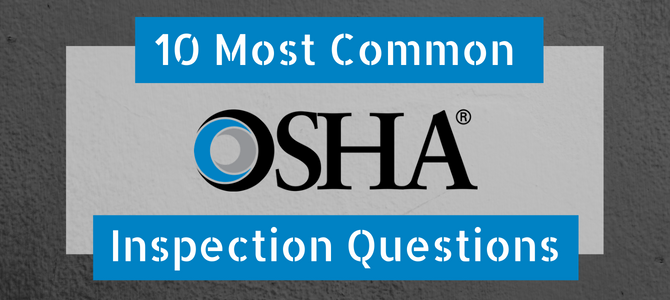10 Most Common OSHA Inspection Questions
Recently, we read an article from EHS Today that included an interview with two former OSHA officers, Nick Walters and Tom Bielema. In the interview, the men answered peoples’ top ten most common questions about OSHA inspections at the AAAP 2018 show in San Antonio, Texas. Between the two of them, they have a combined experience of 47 years with OSHA.
Here are their answers to the top 10 questions asked about inspections:
- Why did OSHA pick my company for an inspection?
OSHA follows a number of priorities when determining which facilities to inspect. Those priorities include:
- imminent danger
- fatalities and catastrophes
- severe injuries (i.e., hospitalization, amputation or loss of an eye)
- employee complaints
- referrals, whether from law enforcement, other government agencies or the media
- programmed inspections, such as National Emphasis Programs (NEP) or Local Emphasis Programs (LEP)
- Can I ask for a copy of the OSHA complaint?
Yes, absolutely.
- Can I ask OSHA to get a warrant?
Again, yes, but you should seriously consider whether you really want to raise the idea in OSHA’s mind that you might have something to hide. All OSHA personnel will present their credentials if you have any reason to question the legitimacy of the inspection or the personnel.
- What documents am I required to provide to the Compliance Officer?
Typical documents requested include the organization’s Federal Employer ID number, OSHA injury and illness logs, written programs, and training records.
- Can I limit the scope of the inspection?
Yes, particularly to manage and limit the risk of providing OSHA more information than you necessarily ought to. For instance, resist the temptation to offer OSHA a full tour of your facility or campus. You should definitely require the Compliance Officer to follow all workplace safety procedures. Also, let them know about any trade secret areas in your facility. You should know the scope of the inspection and limit areas of access and travel routes (where appropriate) to only the areas within that scope.
- How does OSHA decide whether or not I get a citation and what the penalty amount will be?
Penalties are calculated based on severity as well as probability, with mitigating factors including history and good faith. There are four violation types:
- Willful: a violation that the employer intentionally and knowingly commits or a violation that the employer commits with plain indifference to the law. OSHA may propose penalties of up to $129,336 for each willful violation.
- Serious: a violation where there is substantial probability that death or serious physical harm could result and that the employer knew, or should have known, of the hazard. There is a mandatory penalty for serious violations which may be up to $12,934.
- Other-than-serious: a violation that has a direct relationship to safety and health, but probably would not cause death or serious physical harm. OSHA may propose a penalty of up to $12,934 for each other-than-serious violation.
- Repeated: a violation that is the same or similar to a previous violation. OSHA may propose penalties of up to $129,336 for each repeated violation.
- Does OSHA have a quota system?
In a word, no.
- What are my options after I receive a citation?
Companies have three options:
- Accept the citations, correct the conditions and pay the penalty.
- Participate in an informal conference.
- Contest the citations, which must be done in writing within 15 working days of the final order.
- Should I schedule an informal conference and what should I expect when I go to the OSHA office?
They suggest you should always take the informal conference option, where you should be able to get a better explanation of the violation, the standards cited, what is needed to correct the violation, and other issues.
- Can we beat an OSHA citation?
Yes, particularly if the violation is due to employee misconduct. You must be able to prove all four of these:
- A work rule was violated.
- The work rule had been properly communicated.
- Your organization needs to prove it actively monitors compliance to the rules.
- Disciplinary actions were taken.
—
Both Walters and Bielema now work for safety consulting firm Safety Controls Technology, so feel free to poke around their website if you have more questions about OSHA inspections.
Has your dealership been inspected by OSHA? Leave your biggest takeaways in the comments below!


